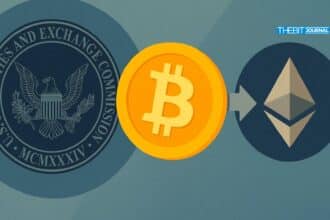According to news sources, on February 20, at CPAC in Washington, D.C., Michael Saylor of Strategy (formerly MicroStrategy) made a bold statement: the United States should buy up to 20% of Bitcoin as a strategic reserve. Saylor argued that this would not only improve the nation’s economic position but also be a great tool to pay down the national debt and make the U.S. a leader in the digital asset space.

A Big Idea: A Bitcoin Strategic Reserve
Michael Saylor’s idea is simple but audacious. He says:
“there’s only room for one nation-state to buy 20% of the network and I think it should be the United States.”
According to Saylor, buying 20% of the 21 million coins in circulation at today’s prices would be around $392 billion. This is bigger than the Strategic Petroleum Reserve which holds about 395 million barrels of oil valued at around $29 billion.
Michael Saylor’s argument is that Bitcoin, as a decentralized asset with no issuer, is digital gold that can help stabilize the finances of a nation. By having a strategic reserve, the U.S. can utilize Bitcoin’s scarcity and resilience to offset economic vulnerabilities.
One of the most interesting parts of Saylor’s proposal is his claim that owning 4-6 million BTC could allow the U.S. to pay down the national debt.
“The dollar would strengthen, the nation would be richer,” he said.
He envisions a scenario in which the value of Bitcoin held as a national asset could be used as collateral against the country’s liabilities.
In a world where digital assets are seen as a hedge against inflation, the idea of using Bitcoin to pay off national debt is a brand new tool for fiscal management. This is supported by historical analysis of sovereign wealth funds and alternative reserve assets.
Bitcoin as a Reserve Asset
One of the main points Michael Saylor makes is that Bitcoin is the perfect reserve asset.
“Bitcoin is a commodity, an asset without an issuer,” he said, “it cannot be corrupted by any company, individual or nation.”
Because of this he says it has achieved “escape velocity” in the global financial system.
Strategy—the company led by Michael Saylor—has the largest corporate Bitcoin portfolio with 478,740 BTC valued at around $47 billion and a dollar cost average of $65,000 per coin. Despite the volatility, these holdings have returned 51% and increased the company’s stock price 360% over the past year. This is proof that when managed well, Bitcoin can be a great asset in national economic planning.

Regulatory and Geopolitical Considerations
Saylor’s proposal isn’t made in a vacuum. He warned if the US doesn’t act, other nations like China, Russia, Saudi Arabia or European countries will get a big piece of the Bitcoin pie first. The geopolitical race for digital assets is heating up, with several US states (Illinois, Kentucky, Maryland, Texas) already looking to hold Bitcoin and other cryptos in their reserves.
The favorable regulatory environment, partly due to President Donald Trump’s pro-crypto stance has Saylor’s argument looking even stronger. Trump’s public support for digital currencies and his vision to make Bitcoin the national reserve has raised expectations for a more pro-innovation regulatory framework in the US.
In addition to national reserves, Michael Saylor’s comments also tie into corporate strategy. Strategy recently announced plans to raise $2 billion in 0% senior convertible notes to buy more Bitcoin. This funding will be a big vote of confidence in Bitcoin’s long term value.
The funding will not only allow for more aggressive buying of Bitcoin but also make Strategy a major player in the institutional space. This will have a ripple effect on market sentiment and other institutional investors could consider similar positions.
Technical and Market Analysis: Can the US Pull off Saylor’s Vision?
From a market perspective, buying a strategic reserve of Bitcoin isn’t small potatoes. At current prices, buying 20% of all Bitcoin would require a massive amount of capital of almost $392 billion. However, proponents argue the benefits (strengthening the national currency, reducing debt) far outweigh the challenges.
Key market data points:
– Bitcoin’s Performance:
As Bitcoin is seen as a “digital gold”, its price and history of resilience are important. Despite volatility, Bitcoin’s long term trend is up and that makes it a reserve asset.
– Institutional Confidence:
Strategy’s own success with big profits and a large Bitcoin portfolio shows institutional confidence in Bitcoin. Analysts at have noted that investing in Bitcoin can be a hedge against economic instability.
– Global Competitive Landscape: The risk of other nations creating their own digital reserves is the biggest argument for US action now. A national Bitcoin reserve could not only stabilize the economy but also be a strategic asset in global financial negotiations.

Metrics: A Quick View
Here are the key numbers that support Saylor’s proposal:
| Metric | Figure | Meaning |
| Total Bitcoin Supply | ~20 million coins | 20% target ≈ 4 million coins |
| Cost for 20% of Bitcoin | ~$392 billion | Big number but has strategic long term value |
| Strategy’s Bitcoin Holdings | 478,740 BTC (~$47 billion) | Institutional confidence |
| Profit from Bitcoin Holdings | 51% profit, 360% stock price increase | Successful strategic Bitcoin investments |
| Funding for Expansion | $2 billion in convertible notes | Buying more Bitcoin |
Deep Dive: National Digital Reserves
The idea of a national digital reserve isn’t new; several countries have considered using digital assets to hedge against economic instability. However, Michael Saylor’s proposal is huge in scale. He’s suggesting the U.S. buy up to 20% of Bitcoin. That’s a total paradigm shift in how national financial security is imagined.
The comparison to traditional reserves like the Strategic Petroleum Reserve is striking. The Strategic Petroleum Reserve reportedly has 395 million barrels of oil worth about $29 billion. A Bitcoin reserve would be way more valuable and symbolic. This big idea hinges on a few things. If the U.S. were to buy that much Bitcoin, it could use it as collateral to stabilize the dollar and pay down the national debt.
The U.S. would have a strategic advantage over other countries, many of which are already exploring digital assets as part of their economic strategy. A national reserve would spur more innovation in the digital asset space, set a global precedent for how cryptocurrencies are integrated into national financial systems.
Conclusion
Michael Saylor’s call for the U.S. to build a strategic Bitcoin reserve by buying up to 20% of the network is a big deal. Backed by Strategy’s own Bitcoin investments and in a competitive world, this is a clear call to action to get a modern financial reserve.
If done, this could be a major shift in U.S. economic policy and set a powerful precedent for digital assets in national fiscal policy. As the debate rages on Capitol Hill and among global leaders, the national Bitcoin reserve is a hot topic—one that will redefine money in the 21st century.
The BIT Journal is available around the clock, providing you with updated information about the state of the crypto world. Follow us on Twitter and LinkedIn, and join our Telegram channel.
FAQ
1. What is Michael Saylor proposing at CPAC?
He’s calling for the U.S. to buy up to 20% of the existing supply of Bitcoin as a reserve to support the economy and pay down the national debt.
2. How much would that cost?
About 4 million Bitcoin at current prices would be around $392 billion.
3. What benefits does Michael Saylor say a Bitcoin reserve would bring?
Michael Saylor says a national Bitcoin reserve would strengthen the dollar, enrich the country and give the U.S. geopolitical leverage by preventing other countries from getting significant digital asset positions.
4. How do Strategy’s current holdings support this?
They hold 478,740 BTC worth about $47 billion with a 51% profit margin. Institutional investment in Bitcoin.
5. What are the regulatory and geopolitical implications?
A U.S. Bitcoin reserve could impact global digital asset regulations, be a hedge against economic collapse and U.S. dominance in the digital financial landscape.
Glossary
Bitcoin Reserve: A proposal for a nation-state to hold a large amount of Bitcoin to stabilize the economy.
Digital Asset: An asset that exists in digital form and is secured by cryptography, like Bitcoin.
Institutional Investment: Big money from banks, funds and corporations.
Strategic Petroleum Reserve: A government stockpile of oil used as a buffer in times of economic crisis; used as a comparison for the Bitcoin reserve proposal.
Convertible Notes: Financial instruments used to raise capital, convertible to equity under certain conditions.
Geopolitical Leverage: Using economic or strategic assets to influence international relations and policy.
On-Chain Analytics: Tools that analyze blockchain data to show transaction trends and investor behavior.




























